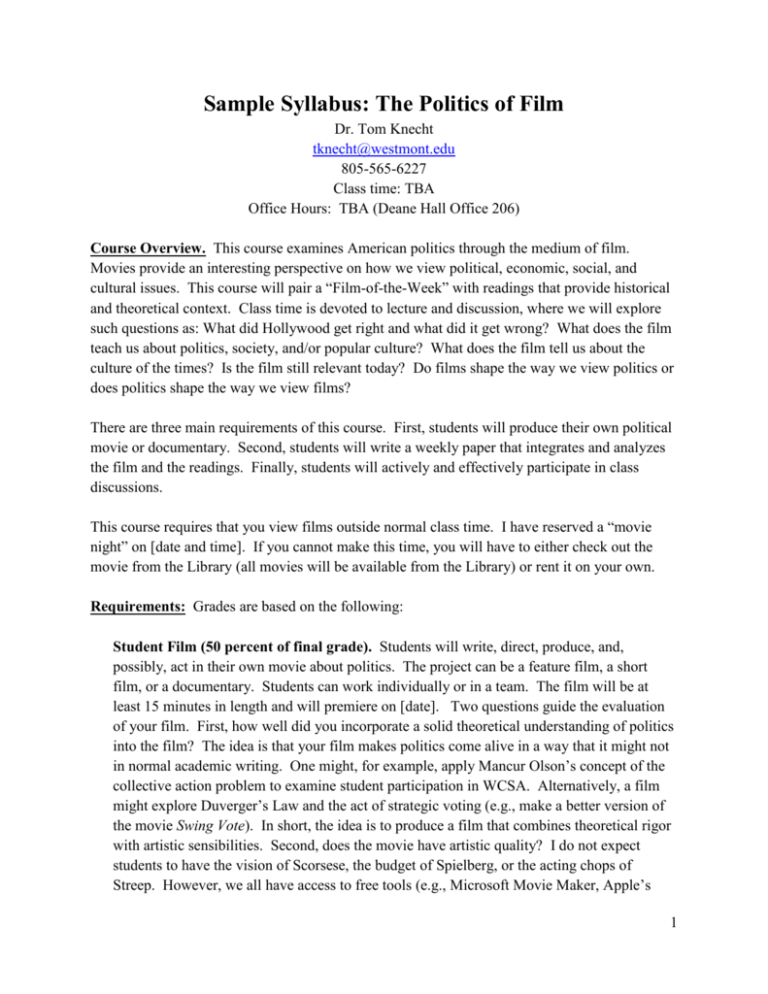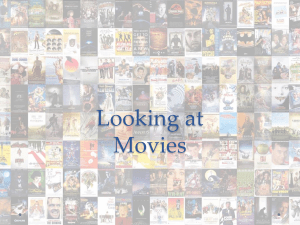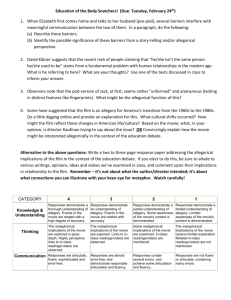Politics of Film Syllabus
advertisement

Sample Syllabus: The Politics of Film Dr. Tom Knecht tknecht@westmont.edu 805-565-6227 Class time: TBA Office Hours: TBA (Deane Hall Office 206) Course Overview. This course examines American politics through the medium of film. Movies provide an interesting perspective on how we view political, economic, social, and cultural issues. This course will pair a “Film-of-the-Week” with readings that provide historical and theoretical context. Class time is devoted to lecture and discussion, where we will explore such questions as: What did Hollywood get right and what did it get wrong? What does the film teach us about politics, society, and/or popular culture? What does the film tell us about the culture of the times? Is the film still relevant today? Do films shape the way we view politics or does politics shape the way we view films? There are three main requirements of this course. First, students will produce their own political movie or documentary. Second, students will write a weekly paper that integrates and analyzes the film and the readings. Finally, students will actively and effectively participate in class discussions. This course requires that you view films outside normal class time. I have reserved a “movie night” on [date and time]. If you cannot make this time, you will have to either check out the movie from the Library (all movies will be available from the Library) or rent it on your own. Requirements: Grades are based on the following: Student Film (50 percent of final grade). Students will write, direct, produce, and, possibly, act in their own movie about politics. The project can be a feature film, a short film, or a documentary. Students can work individually or in a team. The film will be at least 15 minutes in length and will premiere on [date]. Two questions guide the evaluation of your film. First, how well did you incorporate a solid theoretical understanding of politics into the film? The idea is that your film makes politics come alive in a way that it might not in normal academic writing. One might, for example, apply Mancur Olson’s concept of the collective action problem to examine student participation in WCSA. Alternatively, a film might explore Duverger’s Law and the act of strategic voting (e.g., make a better version of the movie Swing Vote). In short, the idea is to produce a film that combines theoretical rigor with artistic sensibilities. Second, does the movie have artistic quality? I do not expect students to have the vision of Scorsese, the budget of Spielberg, or the acting chops of Streep. However, we all have access to free tools (e.g., Microsoft Movie Maker, Apple’s 1 iMovie, your cell phone) that make shooting and editing videos fairly simple. Moreover, it is easy to distinguish films that are poorly planned and executed from those that are produced with love and care. Although this is not necessarily a class on film theory, we will cover some movie making techniques that will help you complete the project. Please note that this is a semester-long project and I expect your film to reflect that level of work. There are several intermediate due dates (see Course Schedule) to ensure that you are both working diligently on the project and not getting off-track. There are also several resources on Eureka to help you produce and edit your student film. Weekly Essay (30 percent of total grade). Students are expected to submit a weekly essay analyzing the readings and the movie for the week. The essay should be 500-700 words in length, typewritten, and double-spaced. Your essay should strive for original analysis over summary. Essays will be evaluated on the quality of thought and clarity of prose. Essays are due the following Monday at 5:00 pm. Participation (20 percent of total grade). This class will rely heavily on student participation. There are two components to the participation grade. First, you are expected to attend all lectures and show up to class on time. Second, you are expected to actively participate in class discussions. This means that you must complete all the readings before class and be prepared to discuss the course material. Please remember to participate in class discussions without dominating the conversation. Late Policy. Late work will be penalized 1 letter grade per day, except for the student film which will be penalized two letter grades for each late day. Required Texts Hass, Elizabeth, Terry Christensen, and Peter J. Hass (2015). Projecting Politics: Political Messages in American Films, 2nd Edition. New York: Routledge. Readings on Eureka. General Education This course fulfills the general education requirement under Common Inquiries called Understanding Society. The Westmont College Catalog offers this definition of Understanding Society: “Students will study social phenomena analyzing and explaining a wide and varied range of human behavior and social institutions and practices. Students should recognize the dynamic interplay among individuals, societal infrastructure, and public policy. Students should also understand the processes of the political economy, the 2 nature of technology and innovation as social phenomena, and the interaction of private enterprise and the public sector. Through exposure to a breadth of literature regarding models or theories that explain social phenomena, students will acquire basic competence to evaluate these phenomena through observation, data collection, and quantitative and qualitative analysis. Students should reflect on the applications of contemporary technological advances and their impacts on personal relationships, research methodologies, the inquiry process, and the accumulation and dissemination of new knowledge” (see http://www.westmont.edu/_offices/registrar/documents/Catalog.pdf pp. 22-3). Course objectives and learning outcomes. The Politics of Film gives students an opportunity to: understand foundational theories of politics, society, economics, and culture. analyze how institutions, or the rules of the game, shape public policy. survey American public policy, including budgetary, foreign, and domestic policy. reflect on whether Hollywood movies mirror society or shape society. study the process by which individuals come to hold their political ideology and partisan affiliation. assess how technological advances (e.g., the Internet, 24-hour news broadcasts) have shaped the media and film. learn how to produce, direct, and, possibly, act in a film. make personal and social applications of various theories—informed by a biblical perspective. reflect on the role that Christians play, or ought to play, in the American political system. assess the similarity and differences between social scientists and Hollywood. Academic Integrity: Academic dishonesty will not be tolerated. It should be noted that I am vigilant about checking the authenticity of students’ work and have no qualms about prosecuting violators. If you have any questions of what constitutes academic dishonesty, please ask me or refer to Westmont’s policy at http://www.westmont.edu/_offices/registrar/academic_policies/academic-dishonesty.html. Academic Accommodations: Students who have been diagnosed with a disability (learning, physical/medical, or psychological) are strongly encouraged to contact the Disability Services office as early as possible to discuss appropriate accommodations for this course. Formal accommodations will only be granted for students whose disabilities have been verified by the Disability Services office. These accommodations may be necessary to ensure your full 3 participation and the successful completion of this course. For more information, contact Sheri Noble, Director of Disability Services (565-6186, snoble@westmont.edu) or visit the website http://www.westmont.edu/_offices/disability Course Schedule. This schedule is subject to change with prior notification. Please note that some of the movies we watch contain disturbing images, violence, and bad language. Week 1. Introduction Week 2. The Individual or The Collective? Movie: Antz Readings: Hass et al., chs 1-3. Rosen and Wolff (eds.), Political Thought, pp. 53-76 (Locke, Weber, Hobbes, Locke, Rousseau, Kant, Hume, Bentham, Hegel, Hart, Bakunin, and Wolff, Aesop) Additional Movies: The Matrix; V is for Vendetta Assignment Due: The Movie Pitch. For this assignment, you give a 5 minute oral pitch to the class. Collectively, we will ask questions, provide guidance, and ultimately decide whether to greenlight your project. Week 3. Elections Movie: The Candidate Readings: Hass et al., ch. 9 Abramowitz, Alan (2008) “Forecasting the 2008 Presidential Election with the Time-For-Change Model.” PS: Political Science & Politics, 41(04): 691695. Olivola, Christopher Y. and Alexander Todorov (2010), “Elected in 100 Milliseconds: Appearance-based Trait Inferences and Voting,” Journal of Nonverbal Behavior 34(2): 83-110. Miller, Arthur H., Martin P. Wattenberg, and Oksana Malanchuk (1986), “Schematic Assessments of Presidential Candidates” The American Political Science Review, 80: 521-540. Farhi’s “Do Campaigns Really Change Voters’ Minds?” Masket’s “If Campaign Effects Are Minimal, Why Even Try?” Additional Movies: Bulworth; Election; Game Change; The War Room; The Manchurian Candidate; Primary Colors Week 4. Congress. 4 Movie: Mr. Smith Goes to Washington Readings: Hass et al, ch. 5 Mann, Thomas E. and Norman J. Ornstein (2006), The Broken Branch: How Congress is Failing America and How to Get it Back on Track. New York: Oxford Press. (selections) Koger, Gregory (2013), “Filibustering and Parties in the Modern Senate,” in Lawrence C. Dodd and Bruce I. Oppenheimer’s Congress Reconsidered, Los Angeles: Sage, pp. 221-236 Sinclair, Barbara (2013), “The New World of U.S. Senators,” in Lawrence C. Dodd and Bruce I. Oppenheimer’s Congress Reconsidered, Los Angeles: Sage, pp. 1-26. Ezra Klein’s “Let’s Talk.” Additional Movies: Advise and Consent; Bulworth Assignment Due: Storyboards. By this date, you will have storyboarded much of your film. This includes: determining location, specifying the number and types of actors needed, props, the type of shot, lighting, and a working script. Week 5. The Presidency Movie: Lincoln Readings: Goodwin’s Team of Rivals, chs., 1-4 Additional Movies: The American President; JFK; Nixon; Seven Days in May Week 6. The Courts Movie: 12 Angry Men Readings: Hass et al., ch. 7 Dwyer, Timothy (2016), “One Juror between Terrorist and Death,” The Washington Post, May 12. Hastie, Reid, Steven D. Penrod, and Nancy Pennington (1983), Inside the Jury, Clark, N.J.: Lawbook Exchange, chs. 2-3 & 10 Radelet, Michael L. and Marian J. Borg (2000), “The Changing Nature of the Death Penalty,” Annual Review of Sociology, 26: 43-61 Additional Movies: Erin Brockovich; The Life of David Gale Week 7. The Press Movie: All the President’s Men Readings: McChesney, Robert W. (2015), Rich Media, Poor Democracy, New York: Taylor 5 and Francis, Introduction-ch. 3 Perry, James M. (n.d.), “Watergate Case Study” Columbia University Shepard, Geoff (2013), “The Watergate Cover Up Trial: Justice Denied,” The Atlantic, Online August 9. Additional Movies: The China Syndrome; The Control Room; Wag the Dog; Network Week 8. Civil Rights Movie: Selma Readings: Morris, Aldon D. (1984), The Origins of the Civil Rights Movement. New York: The Free Press, pp. 1-138. Morris, Aldon D. (1999), “A Retrospective on the Civil Rights Movement,” Annual Review of Sociology, 25: 517-39. Drew, Elizabeth (2015), “Selma vs. History” The New York Review of Books. Additional Movies: Ghosts of Mississippi; Malcolm X; Mississippi Burning Week 9. Interest Groups Movie: Thank You for Smoking Readings: Hass et al., ch. 12 Wright, John R. (1998) “Tobacco Industry PACs and the Nation’s Health: A Second Opinion,” in Paul Herrnson et. al., The Interest Group Connection, Chatham, N.J.: Chatham House Publishers, Inc. McIntosh, Wayne V. and Cynthia L. Cates (2005), “Cigarettes, Firearms, and the New Litigation Wars: Smoking Guns Behind the Headlines,” in Herrnson et. al. (eds.), The Interest Group Connection, Washington DC: CQ Press. Olson, Mancur (1965), The Logic of Collective Action, Cambridge: Harvard University, ch. 1. Schattschneider, E.E. (1960), The Semi-Sovereign People, New York: Holt, Rinehart and Wilson, 1960. McFarland, Andrew S. (1992), “Interest Groups and the Policymaking Process: Sources of Countervailing Power in America,” in Mark P. Petracca (ed.) The Politics of Interests, Boulder: Westview Press. Additional Movies: Bowling for Columbine; Casino Jack Week 10. Obedience Movie: A Few Good Men Readings: Milgram, Stanley (1963), “Behavioral Study of Obedience” The Journal of Abnormal and Social Psychology, 67(4) 6 Rosen and Wolff (eds.), Political Thought, pp. 76-85 (Plato, Thoreau, Martin Luther King, Rawls) Additional Movies: Cool Hand Luke; The Experiment; V is for Vendetta; Rope Week 11. The Cold War Movie: Red Dawn Readings: Hass et al., ch. 10 Sharp, Joanne, Condensing the Cold War Additional Movies: Top Gun, Hunt for Red October, The Day After; Invasion USA; White Nights; Iron Eagle; Assignment Due. Principal Photography Wrap. By this date, you will have completed your pre-production filming. We will have a wrap party as we watch the greatest movie ever made: Red Dawn. Week 12. War Movie: Apocalypse Now Readings: Hass et al., ch. 9 Conrad, Joseph (1902) Heart of Darkness, Additional Movies: Born on the Fourth of July; Crimson Tide; The Deer Hunter: Deterrence; First Blood; Full Metal Jacket; Good Morning Vietnam; The Hurt Locker; Hunt for Red October; Judgement at Nuremberg; MASH; Munich; Patton; Platoon; Red Dawn; Restrepo; Top Gun; Week 13. Foreign Policy Movie: Dr. Strangelove Readings: Lebow and Stein (1995), “Deterrence and the Cold War,” Political Science Quarterly, 110(2): 157-181. Kaplan, Fred (1991), The Wizards of Armageddon, Stanford: Stanford University Press, pp. 1-73; 185-231 Schlosser, Eric (2014) “Almost Everything in ‘Dr. Strangelove’ Was True”. The New Yorker, January 17. Additional Movies: Argo, Charlie Wilson’s War; The Constant Gardener; Fail Safe; The Fog of War; Zero Dark Thirty; The Manchurian Candidate; Seven Days in May; Thirteen Days; Three Days of the Condor; Wag the Dog Week 14. Gender and Public Policy Movie: North Country 7 Readings: Rosen and Wolff (eds.), Political Thought, pp. 34-52 (Plato, Aristotle, Rousseau, Wollstonecraft, Mill, Gilligan, Jaggar). Burgess, Diane and Eugene Borgida (1999), “Who Women Are, Who Women Should Be: Descriptive and Prescriptive Gender Stereotyping in Sex Discrimination.” Psychology, Public Policy, and Law, 5(3): 665-693. Additional Movies: Chinatown; The Corporation; Enron: The Smartest Guys in the Room; Elysium; Milk; The Pursuit of Happyness; The Right Stuff; Traffic; Wall Street; Roger and Me, Wall Street Assignment Due: Post-Production. On this date, you will have finished editing your movie. Week 15. The Westmont Film Festival Assignment Due: Westmont College rolls out the red carpet for our movie premier. This is a gala affair, where we dress to the nines, chat up the press corps (“Dr. Covington, who are you wearing?!?”), and nosh on fine hors d’oeuvers while we rub elbows with the glitterati. Each director will briefly introduce their film and then take questions from the audience after the credits roll. Variety calls it: “The one night you don’t want to miss. Forget Cannes and forget Sundance. The new epicenter of the film world is Winter Hall!” 8






